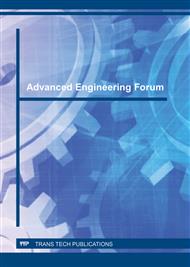[1]
Jong-Fil Moon, Yong Tae Yoon, Sang-Seung Lee, Jae-Chul Kim, Hee-Tae Lee, Geun-Pyo Park, Reliability-Centered Maintenance Model to Managing Power Distribution System Equipment, Power Engineering Society General Meeting IEEE, (2006).
DOI: 10.1109/pes.2006.1709186
Google Scholar
[2]
Xiaodong Yao, Emmanuel Fernández-Gaucherand, Michael C. Fu, and Steven I. Marcus, Optimal Preventive Maintenance Scheduling in Semiconductor Manufacturing. IEEE Transactions on Semiconductor Manufacturing. Vol. 17 No. 3 (2004) 345 – 356.
DOI: 10.1109/tsm.2004.831948
Google Scholar
[3]
N. Sortrakul, H.L. Nachtmann, C.R. Cassady, Genetic algorithms for integrated preventive maintenance planning and production scheduling for a single equipment. Computers in Industry. 56 (2005) 161–168.
DOI: 10.1016/j.compind.2004.06.005
Google Scholar
[4]
Lin Li & Jun Ni, Short-term decision support system for maintenance task prioritization, Int. J. Production Economics. 121 (2009) 195–202.
DOI: 10.1016/j.ijpe.2009.05.006
Google Scholar
[5]
F.A. Van der Duyn Schouten and S.G. Vanneste, Maintenance optimization of a production system with buffer capacity. European Journal of Operational Research. Volume 82 (1995) 323-338.
DOI: 10.1016/0377-2217(94)00267-g
Google Scholar
[6]
Jun Ni, Xi Gu, Xiaoning Jin, Preventive maintenance opportunities for large production systems, CIRP Annals - Manufacturing Technology. 64 (2015) 447–450.
DOI: 10.1016/j.cirp.2015.04.127
Google Scholar
[7]
M. Assid, A. Gharbi, A. Hajji, Production Planning and Opportunistic Preventive Maintenance for Unreliable One-Machine Two-Products Manufacturing Systems, Science Direct IFAC-Papers On Line, 48-3 (2015) 478–483.
DOI: 10.1016/j.ifacol.2015.06.127
Google Scholar
[8]
Martin Bornschlegl, Markus Bregulla, Jörg Franke, Methods-Energy Measurement – An approach for sustainable energy planning of manufacturing technologies, Journal of Cleaner Production. Volume 135 (2016) 644–656.
DOI: 10.1016/j.jclepro.2016.06.059
Google Scholar
[9]
Salonen, A., Deleryd, M., Cost of poor maintenance: A concept for maintenance performance improvement, Journal of Quality In Maintenance Engineering. 17 (2011) 63-73.
DOI: 10.1108/13552511111116259
Google Scholar
[10]
Omar Al-Turki, Tahir Ayar, Bekir Sami Yilbas, Ahmet Ziyaettin Sahin, Chapter 2 Maintenance in Manufacturing Environment: An Overview, Integrated Maintenance Planning in Manufacturing Systems. (2014) 5-23.
DOI: 10.1007/978-3-319-06290-7_2
Google Scholar
[11]
M. Bornschlegl, S. Kreitlein, M. Bregulla, J. Franke, A Method for Forecasting the Running Costs of Manufacturing Technologies in Automotive Production during the Early Planning Phase, Procedia CIRP. Volume 26 (2015) 412-417.
DOI: 10.1016/j.procir.2014.07.103
Google Scholar
[12]
John M Konopka, Capacity Utilization Bottleneck Efficiency System-CUBES, IEEE Transactions on Components Packaging and Manufacturing Technology Part A. 18(3) (1995) 484 – 491.
DOI: 10.1109/95.465141
Google Scholar
[13]
Trybula W.J., Applying SEMI E10 Guidelines to Manufacturing. Electronics Manufacturing Technology Symposium, Low-Cost Manufacturing Technologies for Tomorrow's Global Economy. Proceedings IEMT Symposium., Sixteenth IEEE/CPMT International (1994).
DOI: 10.1109/iemt.1994.404723
Google Scholar


